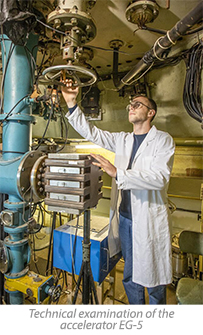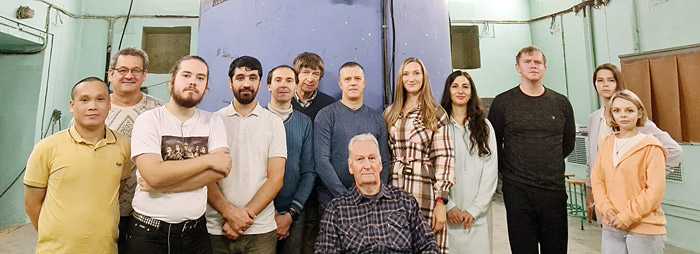EG-5 accelerator: from breeding drought-resistant rice to stellar nucleosynthesis
Media, 18 October 2022
EG-5 is a long-liver among Joint Institute’s facilities, which remains at the forefront of science due to its unique characteristics. This facility is used to solve an extensive range of fundamental and applied challenges in nuclear physics, solid state physics, and radiation technologies. In 2022, this multifunctional accelerator at the Laboratory of Neutron Physics JINR produced striking results in the fields of alternative energy as well as advanced electronics, e.g. the effect of rectifying contact between two nanoparticles was detected for the first time. The facility is developing and challenging itself to embrace new areas of knowledge.
This reliable instrument has been in operation since 1965. It now enables the study of nuclear reactions of neutrons with a solid body accompanied by the emission of charged particles, studies of the elemental depth profiles of multilayer semiconductor architectures, as well as the irradiation of materials.
EG-5 occupies a unique niche among the Joint Institute’s accelerator facilities, as it provides sufficiently intense (1012particles/cm2) fluxes of quasi-monoenergetic accelerated (up to 1-2.5 MeV) charged particles (single-charged hydrogen, helium or deuterium ions) and fast neutrons (4.1 ± 0.1 MeV). “Such a small energy dispersion cannot be obtained using relatively cheap rechargeable, tandem, electrostatic accelerators, not to mention accelerators based on other physical principles,” FLNP JINR EG-5 Group Leader Aleksandr Doroshkevich noted. The ion beam of the accelerator at relatively high current (up to 100 μA) has a very high-energy stability, so that EG-5 can operate both as a neutron generator and as an ion source for ion beam analysis. The accelerated ion beam is distributed via the ion guides to one of the six beamlines equipped with terminal devices. Terminal devices are separate nuclear physics facilities, each of which is unique in its own way within both JINR and the Member States. EG-5 is currently the only single-stage electrostatic accelerator at JINR.
Altogether, these characteristics make it possible to obtain brilliant results at the accelerator every year. In 2022, a group of FLNP scientists obtained significant results in the field of powder nanotechnologies. It is about developing new devices for advanced electronics and alternative energy. In particular, FLNP specialists have recorded a clear effect of rectifying contact between two nanoparticles of different sizes for the first time. This is an absolutely new word in the development of electronics, as this phenomenon allows us to move towards so-called homogeneous electronics. Such electronics will be devoid of the basic disadvantage of doped semiconductors, diffusion instability, which causes any semiconductor device to malfunction eventually. Obviously, both the familiar appearance of the devices and their operation modes will change.
FLNP JINR group in cooperation with NUST MISiS has conducted a number of successful experiments on the irradiation of semiconductor crystals with hydrogen. As a result, an agreement with Russia’s largest electronics manufacturer, Mikron, was reached to prepare equipment and carry out a future technological operation of hydrogen ion implantation in the production of powerful high-voltage diodes.
 The situation is the same in the renewable energy sector. Specialists of the laboratory work with other international research groups to develop devices based on zirconium oxide nanopowders. Such powders are capable of converting moisture adsorption energy into an electric type. Moisture adsorption energy is a rather serious and prospective source of energy. For example, a building weighing 1000 tonnes, approximately a 6-storey house, generates 15 MJ of heat when adsorbing just 5 wt% of moisture from the atmosphere. This energy release will occur, for example, when the circadian cycle changes from day to night. The energy production is sufficient to be used in the active energy infrastructure of new generation buildings. The main challenge at this stage is the extremely low efficiency of adsorption hydropower converters,” Aleksandr Doroshkevich says. “We have been working on this topic as part of the international project under the HORIZON 2020 programme. Our young scientists are now working on powder technology for alternative energy and advanced electronics on their own.”
The situation is the same in the renewable energy sector. Specialists of the laboratory work with other international research groups to develop devices based on zirconium oxide nanopowders. Such powders are capable of converting moisture adsorption energy into an electric type. Moisture adsorption energy is a rather serious and prospective source of energy. For example, a building weighing 1000 tonnes, approximately a 6-storey house, generates 15 MJ of heat when adsorbing just 5 wt% of moisture from the atmosphere. This energy release will occur, for example, when the circadian cycle changes from day to night. The energy production is sufficient to be used in the active energy infrastructure of new generation buildings. The main challenge at this stage is the extremely low efficiency of adsorption hydropower converters,” Aleksandr Doroshkevich says. “We have been working on this topic as part of the international project under the HORIZON 2020 programme. Our young scientists are now working on powder technology for alternative energy and advanced electronics on their own.”
Work on other topics, such as nuclear physics, biology, and radiation materials science, is also being carried out at EG-5. The research group has several scientific directions to pursue, including the development of advanced electronic devices (homogeneous nanoelectronics), the development of drought-resistant rice varieties and research into the astrophysical processes of stellar nucleosynthesis.
The EG-5 accelerator is developing. The technical subgroup carries out a large amount of work, not only on repairing units, but also on their modernisation. Preparations for the installation of a unique microbeam spectrometer have started on the beamline 2 of the accelerator. There are only a few such devices in the JINR Member States. This research facility will allow the analysis of microscopic objects from rough surfaces and the irradiation of separate cell organoids. Such a spectrometer can be used in the production of microsystem technology devices, nanoelectronics. Its emergence opens up a whole range of possible interdisciplinary investigations.
After the upgrade, EG-5 will also get a neutron generator. In addition to the gas neutron-producing target, solid state lithium targets will be installed. This will enable fast neutron activation analysis, irradiating objects to relatively large fluences with variations in temperature, pressure or magnetic fields. Such functionality will certainly be attractive to researchers not only from JINR, but also from other scientific institutes. A user programme is planned for EG-5 in this regard.
“Taking into account the high potential of the instrument complex and the group working on it, we claim to be a serious player in the FLNP scientific field,” Aleksandr Doroshkevich stressed.
